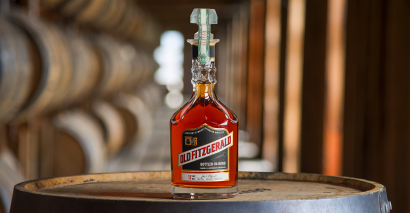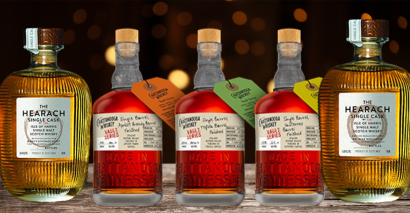![Stagg Jr., Johnnie Walker Blonde & More Whisky [New Releases]](https://mscwordpresscontent.s3.amazonaws.com/wa/wp-content/uploads/2020/12/stagg-jr-15th-edition-hero.jpg?resize=1920x0)
Stagg Jr., Johnnie Walker Blonde & More Whisky [New Releases]
December 18, 2020 –––––– Susannah Skiver Barton

Stagg Jr. (15th Edition)
Style: Straight bourbonOrigin: KentuckyAge: 8 years oldProof: 65.55% ABVPrice: $50Release: December 2020Availability: Limited
Need to know:
Made at Buffalo Trace Distillery and aged at least 8 years, this uncut and unfiltered bourbon shares a similar profile to the more illustrious George T. Stagg.
Whisky Advocate says:
Stagg Jr. comes out a couple of times a year, and while it's not as rare (or expensive) as George T. Stagg, it's still highly in-demand among many bourbon lovers, prized for its undiluted power and rich flavors. We recently reviewed the 13th edition, scoring it 94 points.

Johnnie Blonde
Style: Blended whiskyOrigin: ScotlandAge: Not statedProof: 40% ABVPrice: $25Release: March 2021Availability: Test markets
Need to know:
A new offering from Johnnie Walker, this blend of wheat and fruity malt whiskies is intended for mixing. It's initially launching in global test markets, including Houston in the U.S.
Whisky Advocate says:
It's interesting to see a Johnnie Walker that's being marketed specifically for mixing, since expressions like Johnnie Walker Red and Black already exist and are great options for making a scotch-based cocktail. Johnnie Blonde, however, seems to be playing up softer and sweeter flavors (read: no smoke), and the press release about it specifically mentions mixing with cola, lemonade, or ginger ale. Before you turn up your nose, think about all the people (maybe even you!) who first started drinking whisky with a mixer. This may not set anyone's world on fire, but if it gets more people enjoying whisky then that's A-OK in my book.

Cascade Moon Edition No. 2
Style: Tennessee whiskeyOrigin: TennesseeAge: Not statedProof: 45% ABVPrice: $250Release: December 2020Availability: Limited edition; for sale in CA, TN, and TX
Need to know:
This whiskey blends less than 20 barrels of varying ages, including the first barrel of Tennessee whiskey filled when the George Dickel Distillery (now called Cascade Hollow Distilling Co.) reopened in 2003 after being closed for several years.
Whisky Advocate says:
Though made at the same distillery as George Dickel, the Cascade Moon series intentionally diverges from the traditional Tennessee whiskey and gives distiller Nicole Austin space to stretch her creative wings. The first release, a whiskey meant to imitate the flavors of gose beer, was announced two months ago. Look for a review of both of these new whiskeys in the Spring issue of Whisky Advocate!

Alberta Premium Cask-Strength Rye
Style: RyeOrigin: CanadaAge: Not statedProof: Varies (cask strength)Price: $70Release: December 2020Availability: Limited
Need to know:
Distilled from 100% rye, this whisky is bottled at cask strength, so its proof will vary from batch to batch—though it's typically above 60% ABV.
Whisky Advocate says:
This whisky was previously available in Canada, and is hitting the U.S. for the first time in limited amounts. We reviewed a past batch for the Buying Guide in 2019, scoring it 91 points.

Hochstadter's Vatted Rye (Batch 3)
Style: Blend of straight ryesOrigin: Multiple Age: Not statedProof: 50% ABVPrice: $60Release: December 2020Availability: 9,000 bottles
Need to know:
This whiskey combines five ryes, hailing from California, Kentucky, Indiana, and Pennsylvania, and ranging in age from 4 to 18 years old.
Whisky Advocate says:
Originally created by Rob Cooper, the Hochstadter's blend varies from batch to batch. No. 1 (released in 2015) and No. 2 (released in 2017) were both comprised of 4-15 year old ryes from Indiana, Kentucky, Pennsylvania, and Alberta, Canada and thus had fairly similar profiles. (Batch No. 1 scored 87 points in the Buying Guide.) This batch drops the Canadian element and adds in California rye, plus the age range is wider, so it's likely to taste somewhat different.

Gordon & MacPhail 1979 Mosstowie 40 year old (Cask No. 20323)
Style: Single maltOrigin: Scotland (Speyside)Age: 40 years oldProof: 49.8% ABVPrice: $2,500Release: December 2020Availability: 164 bottles
Need to know:
Mosstowie was located within Miltonduff Distillery and used straight-necked Lomond stills to create a softly smoky spirit. This whisky was laid down on Sept. 13, 1979, spending its entire maturation in a refill sherry hogshead.

Gordon & MacPhail 1975 Glencraig 44 year old
Style: Single maltOrigin: Scotland (Speyside)Age: 44 years oldProof: 54.2% ABVPrice: $2,500Release: December 2020Availability: 110 bottles
Need to know:
This whisky was also made on Lomond stills, this time at Glenburgie Distillery, and filled into cask on Oct. 30, 1975.
Whisky Advocate says:
Both of these whiskies round out Gordon & MacPhail's 125th anniversary celebration this year, part of a series of four "last casks"—whiskies from distilleries that have closed and thus are vanishingly rare. Mosstowie operated for just 17 years before its stills were dismantled in 1981, and Glencraig had a similarly short life in the 1960s and '70s. Neither whisky was ever intended to be bottled as a single malt, being used instead for blends—but I'd trust Gordon & MacPhail that these casks are something special.

Smooth Ambler Old Scout Port Cask-Finished Rye
Style: Finished ryeOrigin: IndianaAge: Not statedProof: 51.5% ABVPrice: $60Release: December 2020Availability: 450 bottles; for sale at the distillery only
Need to know:
Smooth Ambler makes its first foray into cask finishing with this MGP-distilled rye, which aged for 4 years in new charred oak and then was finished for 4 months in French oak port casks.
Whisky Advocate says:
Though it's mainly kept quiet since bringing back Old Scout bourbon last year, Smooth Ambler hasn't been idle. CEO and head distiller John Little says this cask-finished rye won't be the last, although the experiments are staying small and mainly intended for tasting room sales for now. But that doesn't mean they won't someday be produced on a larger scale. Stay tuned!




